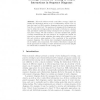678 search results - page 55 / 136 » On Complexity Measures for Biological Sequences |
102
click to vote
FASE
2005
Springer
15 years 4 months ago
2005
Springer
This work defines several control-flow coverage criteria for testing the interactions among a set of collaborating objects. The criteria are based on UML sequence diagrams that a...
GECCO
2004
Springer
15 years 4 months ago
2004
Springer
Aligning multiple DNA or protein sequences is a fundamental step in the analyses of phylogeny, homology and molecular structure. Heuristic algorithms are applied because optimal mu...
80
Voted
RECOMB
2006
Springer
15 years 11 months ago
2006
Springer
Abstract. The understanding of genome rearrangements is an important endeavor in comparative genomics. A major computational problem in this field is finding a shortest sequence of...
115
click to vote
ASM
2008
ASM
15 years 1 months ago
2008
ASM
Abstract. The Mondex case study concerns the formal development and verification of an electronic purse protocol. Several groups have worked on its specification and mechanical ver...
108
click to vote
ICDM
2006
IEEE
15 years 5 months ago
2006
IEEE
A Spatio-Temporal Association Rule (STAR) describes how objects move between regions over time. Since they describe only a single movement between two regions, it is very difficu...

